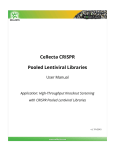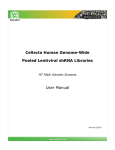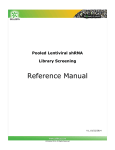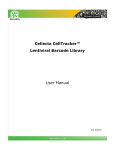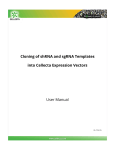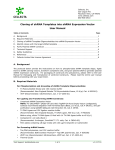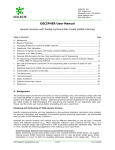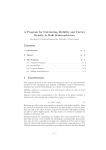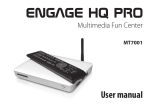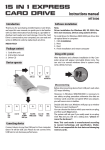Download Cellecta-Manual-Lenti
Transcript
Packaging, Titering, and Transduction of Lentiviral Constructs User Manual V9, 5/10/2015 Lentiviral Packaging, Titering, and Transduction www.cellecta.com User Manual Contents A. Background ....................................................................................................................................... 3 B. Required Materials ................................................................................................................................... 3 C. Recommended Pilot Experiments............................................................................................................. 4 C.1. Doubling Time .................................................................................................................................... 4 C.2. Calculating a Kill Curve ....................................................................................................................... 5 C.3. Check Toxicity of Polybrene ............................................................................................................... 5 C.4. Promoter Validation .......................................................................................................................... 5 D. Packaging Protocol for Individual Lentiviral Constructs ................................................................... 5 D.1. Day 0 – Plate Cells.............................................................................................................................. 6 D.2. Day 1 – Transfection (ten 10-cm plates)............................................................................................ 7 D.3. Day 2 – DNAse I Treatment ............................................................................................................... 7 D.4. Day 3 – Collect Lentiviral Supernatant .............................................................................................. 8 E. Concentrating Virus (Optional) ................................................................................................................. 8 F. Transduction: Lentiviral Titer Estimation .......................................................................................... 9 F.1. Transduction: for Lentiviral Titering................................................................................................... 9 F.1.1. Transduction of Adherent Cells (HEK293 cells): Titering ............................................................ 9 F.1.2. Alternative Transduction Protocol (Spinoculation) for Cells in Suspension: Titering ............... 10 F.2. Lentiviral Titer estimation (RFP assay) ............................................................................................. 10 F.3. Calculating the PuromycinR-Titer ..................................................................................................... 12 G. Transduction of Target Cells: Experimental Purposes ............................................................................ 13 G.1. General Considerations ................................................................................................................... 13 G.2. Transduction Protocol (HEK293) (Easy-to-Transduce Cells) ............................................................ 14 G.2.1. Day 1 ......................................................................................................................................... 14 G.2.2. Day 2 ......................................................................................................................................... 14 G.3. Tet-Regulated Constructs ................................................................................................................ 15 G.3.1. Day 5 (tet-regulated constructs) .............................................................................................. 15 G.3.2. Day 7 (tet-regulated constructs) .............................................................................................. 15 G.4. Non-Tet-Regulated Constructs ........................................................................................................ 15 G.4.1. Day 5 (NON tet-regulated constructs) ...................................................................................... 15 G.4.2. Day 6 or 7 (NON tet-regulated constructs) .............................................................................. 15 [email protected] 2 of 21 v9, 5/10/2015 Lentiviral Packaging, Titering, and Transduction www.cellecta.com User Manual H. Troubleshooting .............................................................................................................................. 15 H.1. Low Lentiviral Titer (<106 TU/ml in supernatant) ............................................................................ 15 H.1.1. Poor transfection efficiency ..................................................................................................... 15 H.1.2. Inefficient production of the virus............................................................................................ 15 H.2. Poor transduction efficiency ..................................................................................................... 16 H.3. Transduction affects target cell viability ................................................................................... 17 H.4. No expression of RFP or PuroR (or shRNAs) in target cells ....................................................... 17 I. Technical Support ........................................................................................................................... 18 J. Safety Guidelines ............................................................................................................................ 19 K. References ...................................................................................................................................... 20 L. Terms and Conditions ..................................................................................................................... 20 A. Background The protocols below provide the instructions on how to package, titer, and transduce target cells with lentiviral expression constructs. The protocols here are useful for any type of lentiviral construct including cDNA expression constructs, shRNA expression constructs, CRISPR constructs, or reporter vectors. Please read the entire user manual before proceeding with your experiment. To ensure you have the latest version of this user manual, please check the Cellecta website at http://www.cellecta.com/resources/protocols. For packaging of Cellecta Pooled shRNA Libraries, please see the appropriate Pooled shRNA Library User Manual according to your needs, available on the Cellecta website at: http://www.cellecta.com/resources/protocols. B. Required Materials Lentiviral expression construct (Custom or premade, from Cellecta; or generated by customer, cDNA, shRNA, CRISPR) Lentiviral Packaging Plasmid mix (Cellecta, Cat.# CPCP-K2A) NOTE: Cellecta’s Packaging Mix is purified by double CsCl gradient. In our experience, CsCl-purified plasmid DNA provides higher and more consistent packaging efficiencies than plasmid DNA purified by anion-exchange column or other method. 293T/17 Cell Line (ATCC, Cat.# CRL-11268™) Dulbecco's Modified Eagle Medium (D-MEM) (1X) (Mediatech CellGro, Cat.# 15-013-CV) NOTE: ADD FRESH GLUTAMINE (1X) at the time a sealed bottle of D-MEM is opened, even if the label indicates glutamine has already been added. Glutamine in solution at +4°C has a half-life of 1–2 months, so glutamine(+) D-MEM purchased “off-the-shelf” from a supplier is to be regarded as glutamine(-). In our experience, the addition of glutamine increases titer approximately 2-fold. If D- [email protected] 3 of 21 v9, 5/10/2015 Lentiviral Packaging, Titering, and Transduction www.cellecta.com User Manual MEM comes supplemented with stable L-Alanyl-L-Glutamine dipeptide, addition of fresh glutamine is not necessary. Glutamine (L-Alanyl-L-Glutamine, Dipeptide L-glutamine) (Mediatech, Cat.# 25-015-CI) HEPES MgCl2 Fetal Bovine Serum (recommended: Mediatech, Cat.# MT 35-010-CV) Puromycin D-PBS (Mediatech, Cat. # 21-031-CV) Trypsin-EDTA (Mediatech, Cat. # 15-040-CV) Polybrene® (hexadimethrine bromide) (Sigma-Aldrich, Cat.# 107689) LentiFuge, lentiviral concentration reagent (Cellecta) 500 ml, 0.2 μm filter units (Fisher Scientific Cat.# 09-741-05 or Thermo Scientific Cat.# 569-0020) Tissue Culture Plates and Related Tissue Culture Supplies Lipofectamine™ Reagent (Life Technologies, Cat.# 18324-020) Plus™ Reagent (Life Technologies, Cat.# 11514-015) C. Recommended Pilot Experiments C.1. Doubling Time The doubling time is the time it takes your model cells to double in number. It is useful to know the doubling time of your cells so that you can plate the appropriate number for transduction with the lentiviral library. Start with cells that have already been growing for a few weeks, rather than using cells that have just been thawed from a frozen state. To calculate the doubling time, trypsinize your cells as if you were going to split them. Count them using a hemacytometer or cell counter and keep track of the number that you replate onto the cell culture plates. The starting number of cells is Xb. Propagate the cells as you normally do, replacing media as necessary. The next time they are ready to be split, trypsinize them as usual, and count them again using a hemacytometer or cell counter. The number of cells at the end is referred to is Xe. The cells should be in the log phase of growth to calculate doubling time properly, so it is important to not let the cells become confluent. To calculate the doubling time: 𝐷𝑜𝑢𝑏𝑙𝑖𝑛𝑔 𝑇𝑖𝑚𝑒 = 𝑇(𝑙𝑛2) 𝑋𝑒 ln( ) 𝑋𝑏 where T= Time in any units (in this case days) For Example, let’s say that on Day 0, you count 2x106 cells. Three (3) days later, you count the cells at 16x106 cells. Xb= 2x106 T= 3 days Xe= 16x106 [email protected] 4 of 21 v9, 5/10/2015 Lentiviral Packaging, Titering, and Transduction www.cellecta.com User Manual 𝐷𝑜𝑢𝑏𝑙𝑖𝑛𝑔 𝑇𝑖𝑚𝑒 = 3(𝑙𝑛2) 3(0.69) 2.08 = = = 1 𝑑𝑎𝑦 16,000,000 ln(8) 2.08 ln( 2,000,000 ) C.2. Calculating a Kill Curve Most vectors from Cellecta that are used to make pooled shRNA libraries have an antibiotic resistance gene, which allows you to select the cells that have received a copy of the shRNA. In order to successfully select your cells, you need to know the concentration of antibiotic that kills your untransduced cells within 72 hours. Antibiotic selection is not necessary for most screens, but it is a convenient way of removing excess cells that have not received the lentiviral vector. It is helpful to use minimal levels of antibiotic so as not to kill cells that just have a weaker expression of the antibiotic resistance gene. Many vectors contain a puromycin resistance gene, therefore we will use this example as to the method of calculating a puromycin kill curve. Aliquot cells in a 12-well plate at such a density so they are at 72 hours from confluency (use the doubling time calculation to help you determine the amount of time this will take). Add puromycin at 0 μg/ml, 0.5 μg/ml, 1 μg/ml, 2 μg/ml, 5 μg/ml, and 10 μg/ml in six different wells. Mix and return cells to incubator. Grow cells under standard conditions for 48-72 hours. For puromycin, use the lowest concentration that kills >90% of cells in 48-72 hours. C.3. Check Toxicity of Polybrene Polybrene is a transduction enhancement reagent used during transduction of lentiviral particles into the target cells. Polybrene is a polycation that neutralizes charge interactions to increase binding between the lentiviral envelope and the plasma membrane. The optimal concentration of Polybrene depends on cell type and may need to be empirically determined. Excessive exposure to Polybrene can be toxic to some cells. Before transducing your target cells we recommended performing a Polybrene toxicity titration. In a 12-well plate, grow cells in complete culture medium with a range of Polybrene concentrations (0 μg/ml, 1 μg/ml, 2 μg/ml, 3 μg/ml, 4 μg/ml, 5 μg/ml) for 24 hours. Then, replace old medium with Polybrenefree complete culture medium and grow cells for an additional 72 hours. Check for toxicity by counting viable cells. For your experiments, use the highest concentration of Polybrene that results in less than 10% cell toxicity compared to no Polybrene (typically, 5 μg/ml is recommended). For some cell types, you cannot use Polybrene. C.4. Promoter Validation If you have not used lentiviral vectors in your target cells before, you may wish to do a pilot experiment to determine which promoters will work best. Most vectors have a cDNA promoter for expression of the RFP and Puro resistance, as well as a shRNA promoter for expression of the shRNA. Cellecta sells prepackaged viruses expressing different marker genes from different promoters. You can use these to determine which promoter combination will work the best for your cells. For more information, please see: http://www.cellecta.com/products-and-services/pooled-lentivirallibraries/control-shRNA-constructs/. D. Packaging Protocol for Individual Lentiviral Constructs The following protocol describes the generation of pseudoviral packaged lentiviral constructs using Invitrogen’s Lipofectamine™ and Plus™ Reagent (see Required Materials). Other transfection reagents may be used, but the protocol should be adjusted to fit the manufacturer’s protocol. The yield of recombinant lentiviral particles typically produced under these optimized conditions is 1 × 106 TU/ml for shRNA constructs. CRISPR constructs or cDNA constructs may have a lower yield depending on the size of the lentiviral construct. This protocol uses 10-cm plates. Multiple plates can be used and viral supernatant combined to increase the yield of virus. [email protected] 5 of 21 v9, 5/10/2015 Lentiviral Packaging, Titering, and Transduction www.cellecta.com User Manual This protocol can be used to package lentiviral vectors expressing shRNA, CRISPR, cDNA, or promoter reporters. 1. Start growing 293T cells in D-MEM medium plus glutamine (see Required Materials), supplemented with 10% FBS without antibiotics, 2 to 3 days prior to transfection. D.1. Day 0 – Plate Cells 2. Twenty four (24) hours prior to transfection, plate 5.5 × 106 293T cells* in 10-cm plates (or 55 cm2 flasks). Use 10 ml of media per plate. Disperse the cells and ensure even distribution. At the moment of transfection, the cells should have reached ~80% confluency. Increase or decrease the number of 293T cells seeded if optimal confluency is not achieved in 24 hours. Incubate at 37°C in a CO2 incubator for 24 hours. * The goal is that the 293T cells should reach 80% confluency by Day 1. You may want to calculate the number of seed cells empirically since cell counts can vary. [email protected] 6 of 21 v9, 5/10/2015 Lentiviral Packaging, Titering, and Transduction www.cellecta.com User Manual D.2. Day 1 – Transfection (ten 10-cm plates) 3. For each construct, mix 20 μl (10 μg) of the Ready-to-use Packaging plasmid mix (see section B for formulation) with 2 μg of the plasmid lentiviral construct and add the plasmid mixture to 1 ml DMEM medium without serum or antibiotics. Add 20 μl of Plus Reagent, mix, and incubate at room temperature for 15 min. one 10-cm plate Ten 10-cm plates Component 60 μl 600 μl Ready-to-use Packaging Plasmid Mix (0.5 μg/μl) 6 μl 60 μl 1,000 μl 10,000 μl 20 μl 200 μl Plus Reagent 1,086 μl 10,860 μl Total volume Plasmid Lentiviral Construct (0.5 μg/μl) D-MEM, no FBS, no antibiotics 4. Make a master mix by combining 30 μl of Lipofectamine Reagent and 1 ml of D-MEM medium without serum or antibiotics per plate. Mix gently. per plate 11X Master Mix* 1,000 μl 11,000 μl 30 μl 330 μl 1,030 μl 11,330 μl Component D-MEM, no FBS, no antibiotics Lipofectamine Total volume *We recommend making enough master mix for one extra reaction to compensate for pipette error. 5. Add 1 ml of the diluted Lipofectamine Reagent (from step 4) to the DNA / Plus Reagent complex (from step 3), mix gently by flicking the tube or vortexing, and incubate at room temperature for 15 min. 6. Add 2 ml of the DNA / Plus Reagent / Lipofectamine Reagent complex (from step 5) to each 10-cm plate from step 2, and mix complexes with medium by gentle rotation. Take care not to dislodge cells from the plate. Incubate at 37°C in the CO2 incubator for 24 hours. D.3. Day 2 – DNAse I Treatment 7. At 24 hours post-transfection, replace the medium containing complexes with fresh 10 ml D-MEM medium supplemented with 10% FBS, DNase I (1 U/ml), MgCl 2 (5 mM), 20mM HEPES pH7.4. Continue incubation in the CO2 incubator at 37°C overnight. Overnight DNase I treatment before harvesting virus does not negatively affect lentiviral titer or infectivity and helps prevent undesirable carryover of plasmid construct into the virus prep. [email protected] 7 of 21 v9, 5/10/2015 Lentiviral Packaging, Titering, and Transduction www.cellecta.com User Manual NOTE: Failure to change the media the day after transfection results in large carryover of plasmid (free and/or Lipofectamine-bound) in your lentiviral prep. This may cause problems with most downstream molecular biology applications, especially whenever there is a PCR step involved. D.4. Day 3 – Collect Lentiviral Supernatant CAUTION: You are working with infectious lentiviral particles at this stage. Please follow the recommended guidelines for working with BSL2 safety class materials (see Safety Guidelines). 8. At 48 hours post-transfection, collect all 10 ml of the virus-containing medium from each plate and filter the supernatant through a Nalgene 0.2 μm PES filter (a low protein binding filter) to remove debris and floating packaging cells. Failure to filter supernatant could result in carry-over of cells into your lentiviral prep. NOTE: Usually, the peak of virus production is achieved at 48 hours post-transfection. Supernatant can also be collected again at 72 hours post-transfection—replace the collected 48-hour supernatant with 10 ml of fresh D-MEM medium supplemented with 10% FBS, 20mM HEPES pH7.4, and continue incubation in the CO2 incubator at 37°C for 24 hours. 9. Proceed to concentration step, or aliquot and store the non-concentrated supernatant at –80°C. Freezing and thawing usually results in ~20% loss of lentiviral titer with each cycle. Cellecta offers lentiviral packaging services. Please contact us at [email protected] or visit our website at http://www.cellecta.com for more information. E. Concentrating Virus (Optional) Although concentrating virus is optional, it is recommended if (1) very high titer virus stock is needed to achieve desired MOI in hard-to-transduce target cells, (2) virus should be suspended in another media (besides DMEM/10%FBS) which is optimal for sensitive target cells, or (3) 18h post-tranduction baseline control is used in your screen (to minimize problems with possible plasmid library carry-over). However, because of the additional manipulation of samples, there is the added risk of contamination and loss of virus. The following protocol was optimized to concentrate virus with high recovery. The protocol assumes that lentiviral supernatant was harvested 48 hours after transfection and filtered as in step 8 above. 1. Aliquot lentiviral supernatant in clear sterile centrifuge tubes. 2. Add LentiFuge according to the LentiFuge user manual instructions. 3. Centrifuge at 15,000 × g for at least 1 hour at +4°C. Mark the tubes to identify the location where the pellet will be. At the end of centrifugation, you may or may not be able to see a pellet—assume it is at the location of the mark. 4. Immediately discard the supernatant by aspirating. 5. Place the tubes on ice, resuspend the (in)visible pellet in PBS, or PBS/ 10% FBS, or PBS/ 1% BSA, make aliquots, and freeze at –80°C. Alternatively, you may concentrate virus by any of the methods below. However, the yield of virus is superior (~80% recovery) using Cellecta’s protocol above. Ultracentrifugation at 50,000 × g for 90 minutes at +4°C Sucrose cushion ultracentrifugation [email protected] 8 of 21 v9, 5/10/2015 Lentiviral Packaging, Titering, and Transduction www.cellecta.com User Manual F. PEG precipitation, followed by centrifugation Transduction: Lentiviral Titer Estimation The following section uses packaged lentiviral particles for transduction into example target cells (HEK293). Please note that lentiviral particles should only be opened within the laminar flow hood, and should be used under biosafety Level 2 conditions. For more information on the biosafety of lentiviral particles, please refer to J. Safety Guidelines, below. F.1. Transduction: for Lentiviral Titering Lentiviral transductions are performed by mixing cells and virus in culture media supplemented with LentiFuge. For both adherent and suspension cells, transductions are initiated in suspension and carried out overnight. Adherent cells are allowed to adhere to substrate during transduction and are transduced at a cell density that allows for 2-3 population doublings before reaching confluence. Suspension cells are typically transduced at higher density than standard growth density, and then they are diluted to standard growth density 18-24 hours after transduction. F.1.1. Transduction of Adherent Cells (HEK293 cells): Titering The following protocol has been optimized for HEK293 cells. For other adherent cell types, parameters such as media, growth surface, time of detection, etc., will have to be adjusted. Day 1 1. Quickly thaw the lentiviral particles in a water bath at 37°C. Transfer the thawed particles to a laminar flow hood, gently mix by rotation, inversion, or gentle vortexing, and keep on ice. CAUTION: Only open the tube containing the lentiviral particles in the laminar flow hood. NOTE: Unused lentiviral stock may be refrozen at –80°C, but it will typically result in a loss of about ~20% in titer. 2. Trypsinize and resuspend HEK293 cells to a density of 1 × 105 cells/ml in D-MEM supplemented with 10% FBS and 5 μg/ml Polybrene. Aliquot 1 ml/well in a 12-well plate and add 0 μl, 3 μl, 10 μl, 33 μl, and 100 μl of lentiviral stock (supernatant filtered to remove cells and cell debris, not concentrated) to six different wells. If concentrated virus is used, scale down virus volumes accordingly. Mix and return cells to CO2 incubator. Grow cells under standard conditions for 24 hours. NOTE: It is important to accurately record the original # of cells at Time of Transduction, as this is critical in titer calculation. For adherent cells other than HEK293, choose a different # of cells at time of transduction, depending on cell size. As a rule of thumb, cells should be transduced at such a density such that they would become confluent in ~48 hours. For example, for HeLa cells, the suggested cell # is 50,000 cells/well in a 12-well plate. Day 2 3. Between 16h-24 hours post-transduction, replace media with fresh D-MEM supplemented with 10% FBS and without Polybrene. Return cells to CO2 incubator, and grow under standard conditions for additional 48 hours. Avoid confluence: trypsinize and re-plate cells if needed. Day 4 (72 hours after transduction) 4. Detach cells from the plate by trypsin treatment, block trypsin with FBS/media, centrifuge, resuspend in 1X D-PBS, and determine the % of transduced (RFP-positive) cells by flow cytometry. NOTE: Attempting to determine the % of transduced cells by fluorescence microscopy is NOT RECOMMENDED. [email protected] 9 of 21 v9, 5/10/2015 Lentiviral Packaging, Titering, and Transduction www.cellecta.com User Manual IMPORTANT: Flow cytometry settings to detect RFP-positive cells are the following: Excitation: 561nm (530nm laser is still acceptable), Emission: 600/20 band-pass filter, or similar (for TagRFP). 5. Proceed to Lentiviral Titer estimation (RFP assay). F.1.2. Alternative Transduction Protocol (Spinoculation) for Cells in Suspension: Titering The following protocol has been optimized for K-562 cells. For other cell types, parameters such as media, growth surface, time of detection, etc. will have to be adjusted. 1. K-562 cells are transduced (“infected”) using spinoculation. This is performed using multi-well tissue culture plates and a tabletop centrifuge capable of 1,200 × g and centrifugation of multi-well plates. 2. Grow K-562 cells and maintain them between 2 × 105 and 1 × 106 cells/ml. Do not let them become too dense or let the medium become yellow at any point. 3. For lentiviral library titration, K-562 cells are resuspended at 2 × 106 cells per ml in RPMI 10% FBS supplemented with 20mM HEPES pH7.4 and Polybrene 5 μg/ml. 0.5-ml aliquots are placed into each well in a 24-well plate (1 × 106 cells/well total). This cell density has proven effective for many suspension cell lines in-house at Cellecta. To each cell-containing well, add increasing amounts of lentiviral stock to be titered. For standard 100-fold concentrated lentiviral stock, add 0 μl, 0.3 μl, 1 μl, 3 μl, and 10 μl virus. Close the plate, mix by gentle agitation, wrap the perimeter with parafilm, and place the plate into centrifuge with an appropriate balance and centrifuge at 1,200 × g at +25°C for 2 hours. 4. Following centrifugation, remove plate(s) from centrifuge, carefully remove parafilm, and place in incubator. After 3 hours, “feed” cells with 0.5 ml additional complete medium per well (no Polybrene). 5. 24 hours after spinoculation, resuspend cells at 2 × 105 cells/ml in RPMI 10% FBS in the appropriate culture vessel and grow for additional 48 hours. 6. 72 hours after spinoculation, perform titer as previously described. NOTE: Use larger vessels for large-scale genetic screen transductions. Scale up all volumes accordingly. F.2. Lentiviral Titer estimation (RFP assay) Lentiviral shRNA vectors that express the fluorescent protein TagRFP (excitation ~560nm, emission ~590nm) allow lentiviral titer estimation by flow cytometry (RFP assay) or by a combined flow cytometry/puromycin resistance assay (RFP/PuroR assay). To check lentiviral titer, we recommend always using the same cells you will use in the screen. Most of the commonly used mammalian cell lines can be effectively transduced by lentiviral constructs. Relative titers can vary up to 50-fold depending on the chosen cell line. Lentiviral titer is measured as Transduction Units/ml (TU/ml). One TU produces one integration event in target cells. Integration events can be calculated from observed % of transduced cells according to the table below. [email protected] 10 of 21 v9, 5/10/2015 Lentiviral Packaging, Titering, and Transduction www.cellecta.com User Manual TITER CHART 100 90 80 % infected cells 70 60 50 40 30 20 10 0 0 0.5 1 1.5 2 2.5 MOI (viral particles /cell) The % of infected cells is determined by flow cytometry (excitation=561nm, emission=600/20 for TagRFP) by observing the % of RFP+ cells in the transduced cell sample. When the % of infected cells is at or below 20%, the # of integrations is (with good approximation) equivalent to the # of transduced cells. At higher transduction efficiencies, the fraction of transduced cells bearing multiple integrations becomes higher and higher, so that the increase in % of transduced cells relative to integration events/cell is no longer linear. Using the table below, MOI (MOI=multiplicity of infection = viral particles/ cell) can be calculated with good accuracy in the range 0.2-1.5 MOI. (For individual constructs, MOI can also be calculated higher than 2.5 in order to achieve >90% transduction efficiency.) Titer is calculated according to the TITER FORMULA below: 𝑇𝑈 𝑀𝑂𝐼 = (# 𝑜𝑓 𝑐𝑒𝑙𝑙𝑠 𝑎𝑡 𝑇𝑟𝑎𝑛𝑠𝑑𝑢𝑐𝑡𝑖𝑜𝑛) ∗ 𝑚𝑙 (𝑚𝑙 𝑜𝑓 𝑉𝑖𝑟𝑎𝑙 𝑆𝑡𝑜𝑐𝑘 𝑢𝑠𝑒𝑑 𝑎𝑡 𝑇𝑟𝑎𝑛𝑠𝑑𝑢𝑐𝑡𝑖𝑜𝑛) Example: IF: The original # of cells at Transduction was 100,000, and The volume of virus stock used was 10 μl, and The observed % of transduced (RFP+) cells is 25%, THEN: The calculated MOI is 0.3 (from the chart), and The TITER is: 100,000 ∗ [email protected] 0.3 = 3,000,000 𝑇𝑈/𝑚𝑙 0.01 11 of 21 v9, 5/10/2015 Lentiviral Packaging, Titering, and Transduction www.cellecta.com User Manual Once titer is estimated, the amount of Lentiviral Stock necessary to transduce any given # of target cells at any transduction efficiency (range of 10-80% infected cells) can be back-calculated from the TITER FORMULA and TITER CHART above. Example: To transduce 20,000,000 cells at 50% transduction efficiency, with a Lentiviral Stock titer of 3,000,000 TU/ml, we calculated the required amount of Lentiviral Stock as follows: We calculate the required MOI to achieve 50% transduction efficiency, using the TITER CHART: 50% transduction efficiency = 0.7 MOI We calculate the volume of Lentiviral Stock required using the TITER FORMULA: 𝑇𝑈 𝑀𝑂𝐼 = (# 𝑜𝑓 𝑐𝑒𝑙𝑙𝑠 𝑎𝑡 𝑇𝑟𝑎𝑛𝑠𝑑𝑢𝑐𝑡𝑖𝑜𝑛) ∗ 𝑚𝑙 (𝑚𝑙 𝑜𝑓 𝑉𝑖𝑟𝑎𝑙 𝑆𝑡𝑜𝑐𝑘 𝑢𝑠𝑒𝑑 𝑎𝑡 𝑇𝑟𝑎𝑛𝑠𝑑𝑢𝑐𝑡𝑖𝑜𝑛) 3,000,000 = (20,000,000) ∗ 0.7 (𝑚𝑙 𝑜𝑓 𝑉𝑖𝑟𝑎𝑙 𝑆𝑡𝑜𝑐𝑘 𝑢𝑠𝑒𝑑 𝑎𝑡 𝑇𝑟𝑎𝑛𝑠𝑑𝑢𝑐𝑡𝑖𝑜𝑛) 0.7 𝑉𝑖𝑟𝑎𝑙 𝑆𝑡𝑜𝑐𝑘 = 20,000,000 ∗ ( ) = 4.67 𝑚𝑙 3,000,000 F.3. Calculating the PuromycinR-Titer If puromycin selection of transduced cells is going to be performed in the screen, the fraction of RFP+ cells (at a given MOI) that will survive puromycin selection must be calculated beforehand. Even though RFP and Puro-resistance markers are expressed from the same promoter, not all cells expressing detectable RFP are guaranteed to be puro-resistant. A threshold of PuroR expression is required to confer puromycin resistance. Depending on cell type, such a threshold is associated with different levels of RFP co-expression. Depending on the MOI used, a different % of RFP+ cells will express enough PuroR to survive puromycin selection (i.e. the higher the MOI, the higher the % of multiple integrants, so the higher the % of RFP+ cells expressing higher levels of PuroR). In order to calculate which fraction of RFP+ cells are going to survive puromycin selection, the following procedure is strongly suggested: Titer virus in target cell line, by flow cytometry (F.2. Lentiviral Titer estimation (RFP assay)). Based on assessed titer, perform a small-scale transduction aiming at 50% infected cells: 3 days after transduction, split cells into 2 samples, grow cells +/- puromycin for an additional 3 days, then analyze both samples by flow cytometry. By looking at the RFP intensity of puromycin-treated cells, calculate the % of cells that survived puromycin selection. The figure below shows FACS analysis of transduced cells—no puromycin selection (blue), puromycin selection (red). 50% of cells were RFP+, 24% of the RFP+ cells were also puromycin-resistant (12% of total). [email protected] 12 of 21 v9, 5/10/2015 Lentiviral Packaging, Titering, and Transduction www.cellecta.com User Manual IMPORTANT: The % of RFP+ cells that are also puromycin-resistant is dependent on MOI, as it increases with the increase of % RFP+ cells bearing multiple integrations. In the example above, 24% of RFP+ cells (12% of total) were puromycin-resistant when cells were infected at MOI 0.7 (50% RFP+ cells). If the same cells would be infected at the recommended MOI of 0.5 (40% RFP+ cells), less than 24% of RFP+ cells would also be puromycin-resistant cells. Conversely, if cells were infected at MOI 2 (85% RFP+ cells), a much higher % than 24% of RFP+ cells would also be puromycin-resistant, due to high % of RFP+ cells bearing multiple integrants and therefore expressing high levels of the puromycin-resistance gene. In the case described above, a 27K library genetic screen was started with at least 46 × 106 cells per replicate and transduction. Cells were infected at MOI 0.7 (50% transduction efficiency) to obtain 23 × 106 infected (RFP+) cells, of which about 5.5 × 106 will be puro-resistant (200 puro resistant cells/shRNA). In your screening experiment, however, we do not recommend using an MOI greater than 0.5. IMPORTANT: Using higher MOIs to achieve >40% RFP+ cells in order to obtain ~20% or more puroresistant cells is not recommended. It is advised to limit the RFP-based MOI to 0.5 (40% RFP+ cells) and use enough cells at transduction to obtain the desired amount of puromycin-resistant transduced cells (at least 200 cells/shRNA). G. Transduction of Target Cells: Experimental Purposes G.1. General Considerations The transduction efficiency of the lentiviral expression construct varies significantly for different cells and experimental conditions, including lentiviral vector concentration, exposure time to lentiviral vector, and growth area of cells. To determine the concentration of lentiviral vector particles required to provide the desired multiplicity of infection (MOI) for your target cells, you should titer the viral stock in the same target cells used in the experiment. Cellecta’s Lentiviral vectors contain a deletion in the 3’LTR that leads to self-inactivation of the lentiviral vector after reverse transcription and integration into genomic DNA. Although more than one copy of a lentiviral construct may be integrated into the genome of a single cell, the lentiviral construct cannot produce infectious viral particles. However, despite these safety features, please remember that you are working with transducible lentiviral vector particles. Although the particles are replication-incompetent, they are infection-competent, so the expression cassette that they carry can potentially infect, integrate, and express in any mammalian cell. Please follow the recommended guidelines for working with Biosafety Level 2 (BSL-2) materials. [email protected] 13 of 21 v9, 5/10/2015 Lentiviral Packaging, Titering, and Transduction www.cellecta.com User Manual G.2. Transduction Protocol (HEK293) (Easy-to-Transduce Cells) Please read the entire protocol before beginning your experiment. For other plate formats and other cell types, the volumes, cell number, and media should be adjusted depending on the growth area of the well or plate and the growth characteristics of the cell type. G.2.1. Day 1 1. Quickly thaw the lentiviral vector particles in a water bath at 37°C. Transfer the thawed particles to a laminar flow hood, gently mix by rotation, inversion, or gentle vortexing, and keep on ice. CAUTION: Only open the tube containing the lentiviral vector particles in the laminar flow hood. NOTE: Unused lentiviral stock may be refrozen at –80°C, but it will typically result in a loss of about ~20% in titer. 2. Trypsinize and resuspend cells to a density of 1 × 105 cells/ml in D-MEM supplemented with 10% FBS and 5 μg/ml Polybrene. Aliquot 1 ml/well in a 12-well plate and add an appropriate amount of lentiviral vector stock to each well. For one well (mock well control), do not add lentiviral vectors. Mix and return cells to CO2 incubator. Grow cells under standard conditions for 24 hours. Note: For shRNA constructs, we recommend starting with an MOI of about 1 (ratio of lentiviral vectors to cells). In some cases, a higher MOI (or multiple integrants per cell) may be needed to reach an optimal knockdown efficiency. For CRISPR constructs (which are large), you may need to increase the MOI to achieve efficient transduction efficiency. G.2.2. Day 2 At 24 hours post-transduction, replace media with fresh D-MEM supplemented with 10% FBS and without Polybrene. Return cells to CO2 incubator, and grow under standard conditions for 24 more hours. G.2.3. Day 3 By day 3, the culture may be confluent (depending on cell type). The cells can be assayed for RFP or GFP expression at this point. Split the cells 1:4 to 1:8, depending on the type of cells, and incubate for 48 hours in complete medium containing antibiotic (puromycin, bleomycin, hygromycin, etc) at 1 ug/ml (or the concentration determined empirically by the Antibiotic Kill Curve). [email protected] 14 of 21 v9, 5/10/2015 Lentiviral Packaging, Titering, and Transduction www.cellecta.com User Manual G.3. Tet-Regulated Constructs G.3.1. Day 5 (tet-regulated constructs) Change media to remove dead cells, dilute culture as needed to keep cells from confluency, split culture into 2 separate samples, and incubate 48 hours in complete medium with Puromycin, with (one sample) or without (the other sample) 0.1 ug/ml dox. G.3.2. Day 7 (tet-regulated constructs) The infected target cells can now be analyzed using an appropriate assay. If a prolonged shRNA expression is required, it is recommend that cells are kept under optimal growth conditions and fed fresh media containing 0.1 ug/ml dox every 48 hours until harvesting. G.4. Non-Tet-Regulated Constructs G.4.1. Day 5 (NON tet-regulated constructs) Change media to remove dead cells, dilute culture as needed to keep cells from confluence, and incubate 24-48 hours in complete medium with Puromycin. G.4.2. Day 6 or 7 (NON tet-regulated constructs) The infected target cells can now be analyzed using an appropriate assay. If prolonged shRNA expression is required, it is recommend that cells are kept under optimal growth conditions until harvesting. H. Troubleshooting H.1. Low Lentiviral Titer (<106 TU/ml in supernatant) H.1.1. Poor transfection efficiency (48 hour post-transfection, less than 80% of 293T cells are very brightly fluorescent) Problem: 293T Cells have too high or too low density Solution: Plate fewer or more cells in order to have about 80% confluency at time of transfection. Problem: Plasmid DNA/Lipofectamine/Plus Reagent ratios are incorrect Solution: Optimize the ratios using the guidelines provided in the Lipofectamine protocol. H.1.2. Inefficient production of the virus Problem: 293T Cells are of poor quality Solutions: Optimize growth conditions, check growth medium, and don’t grow 293T cells for more than 20 passages. Check for mycoplasma contamination. [email protected] 15 of 21 v9, 5/10/2015 Lentiviral Packaging, Titering, and Transduction www.cellecta.com User Manual Do not overgrow the cells (do not allow the cells to reach more than 90% confluency in order to keep the culture continuously in logarithmic growth phase). Problem: Lentiviral supernatant harvested too early or too late Solution: Harvest supernatant 48 hours and 72 hours after transfection. Problem: 293T cell media is too acidic at time of virus harvesting Solution: Make sure to replace media 24 hours before harvesting, and make sure to supplement media with HEPES pH 7.4, 20mM final. H.2. Poor transduction efficiency Problem: Target cells have too high or too low density Solution: Plate fewer or more cells in order to have 20-50% confluency at transduction stage. Problem: Target cell line may be difficult to transduce Solutions: 1) Use a higher concentration of lentiviral particles. 2) Perform “Spinoculation” to improve transduction efficiency. 3) Check to see if Polybrene was added at 5 µg/ml. Problem: Wrong amount of Polybrene added during transduction stage Solution: If Polybrene is toxic to the target cells, optimize Polybrene concentration in the range of 0 – 5 µg/ml by performing a toxicity titration as described in Calculating a Kill Curve Most vectors from Cellecta that are used to make pooled shRNA libraries have an antibiotic resistance gene, which allows you to select the cells that have received a copy of the shRNA. In order to successfully select your cells, you need to know the concentration of antibiotic that kills your untransduced cells within 72 hours. Antibiotic selection is not necessary for most screens, but it is a convenient way of removing excess cells that have not received the lentiviral vector. It is helpful to use minimal levels of antibiotic so as not to kill cells that just have a weaker expression of the antibiotic resistance gene. Many vectors contain a puromycin resistance gene, therefore we will use this example as to the method of calculating a puromycin kill curve. Aliquot cells in a 12-well plate at such a density so they are at 72 hours from confluency (use the doubling time calculation to help you determine the amount of time this will take). Add puromycin at 0 μg/ml, 0.5 μg/ml, 1 μg/ml, 2 μg/ml, 5 μg/ml, and 10 μg/ml in six different wells. Mix and return cells to incubator. Grow cells under standard conditions for 48-72 hours. For puromycin, use the lowest concentration that kills >90% of cells in 48-72 hours. C.3. Check Toxicity of Polybrene Section. Problem: Loss of lentiviral titer during storage Solution: Ensure storage of aliquoted packaged shRNA library at –80°C. Each freeze-thaw cycle typically causes reduction of the titer by ~20%. Use a fresh stock for transduction. Problem: The RFP assay is performed too early [email protected] 16 of 21 v9, 5/10/2015 Lentiviral Packaging, Titering, and Transduction www.cellecta.com User Manual Solution: Normally, the maximal expression of RFP from the integrated provirus is expected to develop by 72 hours after transduction. However, some cells exhibit delayed expression. Try the assay at a later time, such as 96 hours. Problem: The RFP assay is performed with the wrong flow cytometry settings. Solution: RFP+ cells are to be detected using a 561nm laser for excitation (530nm still acceptable) and 600/20 band-pass filters (or similar) for detection (for TagRFP). Using blue laser (488nm) for excitation leads to gross underestimation of viral titer. Problem: In the RFP assay, the % of transduced cells is determined by fluorescence microscopy instead of flow cytometry. Solution: Use flow cytometry. H.3. Transduction affects target cell viability Problem: Polybrene is toxic for target cells Solution: Optimize the concentration and exposure time to Polybrene during the transduction step. For some sensitive cells, Polybrene should not be used. Problem: Virus-containing conditioned media is toxic to target cells. Solution: Concentrate and resuspend the virus in target cell growth media, PBS 10% FBS, or PBS 1% BSA. H.4. No expression of RFP or PuroR (or shRNAs) in target cells Problem: The promoter is not functional in target cells. Solutions: Change the target cells. Contact Cellecta at [email protected] to have the library cloned in another vector with different promoter. [email protected] 17 of 21 v9, 5/10/2015 Lentiviral Packaging, Titering, and Transduction www.cellecta.com User Manual I. Technical Support Please let us know the nature of the problem you are having by answering the following questions. Packaging: What was the lentiviral titer, and what was the total number of TU packaged? How was the virus concentrated? (if applicable) Transducing Target Cells: What MOI did you use to transduce your target cells? What target cells did you use? How many replicates did you use? (i.e. duplicate, triplicate, etc.) Did you use puromycin after transduction, and at what concentration? For how long did you use puromycin on the cells? Please refer to the questions above and contact us by phone or email: Phone: +1 (650) 938-3910 Toll-Free: Fax: +1 (877) 938-3910 +1 (650) 938-3911 E-mail: Technical Support: [email protected] General Information: [email protected] Sales: [email protected] Orders: [email protected] Blog: http://www.cellecta.com/blog/ Postal Mail: Cellecta, Inc. 320 Logue Ave. Mountain View, CA 94043 For more information about Cellecta’s products and services, please visit our web site at http://www.cellecta.com. [email protected] 18 of 21 v9, 5/10/2015 Lentiviral Packaging, Titering, and Transduction www.cellecta.com User Manual J. Safety Guidelines The HIV-based lentivector system is designed to maximize its biosafety features, which include: A deletion in the enhancer of the U3 region of 3’ΔLTR ensures self-inactivation of the lentiviral construct after transduction and integration into genomic DNA of the target cells. The RSV promoter upstream of 5’LTR in the lentivector allows efficient Tat-independent production of lentiviral RNA, reducing the number of genes from HIV-1 that are used in this system. Number of lentiviral genes necessary for packaging, replication and transduction is reduced to three (gag, pol, rev). The corresponding proteins are expressed from different plasmids lacking packaging signals and share no significant homology to any of the expression lentivectors, pVSVG expression vector, or any other vector to prevent generation of recombinant replicationcompetent virus. None of the HIV-1 genes (gag, pol, rev) are present in the packaged lentiviral genome, as they are expressed from packaging plasmids lacking packaging signal—therefore, the lentiviral particles generated are replication-incompetent. Lentiviral particles will carry only a copy of your expression construct. Despite the above safety features, use of HIV-based vectors falls within NIH Biosafety Level 2 criteria due to the potential biohazard risk of possible recombination with endogenous lentiviral sequences to form self-replicating virus or the possibility of insertional mutagenesis. For a description of laboratory biosafety level criteria, consult the Centers for Disease Control Office of Health and Safety Web site at: http://www.cdc.gov/biosafety/publications/bmbl5/bmbl5_sect_iv.pdf It is also important to check with the health and safety guidelines at your institution regarding the use of lentiviruses and follow standard microbiological practices, which include: Wear gloves and lab coat at all times when conducting the procedure. Always work with lentiviral particles in a Class II laminar flow hood. All procedures are performed carefully to minimize the creation of splashes or aerosols. Work surfaces are decontaminated at least once a day and after any spill of viable material. All cultures, stocks, and other regulated wastes are decontaminated before disposal by an approved decontamination method such as autoclaving. Materials to be decontaminated outside of the immediate laboratory area are to be placed in a durable, leakproof, properly marked (biohazard, infectious waste) container and sealed for transportation from the laboratory. [email protected] 19 of 21 v9, 5/10/2015 Lentiviral Packaging, Titering, and Transduction www.cellecta.com User Manual K. References For a complete list of References and Product Citations, please see: http://www.cellecta.com/resources/publications/ L. Terms and Conditions Cellecta, Inc. Limited License Cellecta grants the end user (the “Recipient”) of the Pooled Lentiviral shRNA Libraries and Vector (the “Product”) a non-transferable, non-exclusive license to use the reagents for internal research use only as described in the enclosed protocols; in particular, research use only excludes and without limitation, resale, repackaging, or use for the making or selling of any commercial product or service without the written approval of Cellecta, Inc. -- separate licenses are available for non-research use or applications. The Product is not to be used for human diagnostics or included/used in any drug intended for human use. Care and attention should be exercised in handling the Product by following appropriate research laboratory practices. Cellecta’s liability is expressly limited to replacement of Product or a refund limited to the actual purchase price. Cellecta’s liability does not extend to any damages arising from use or improper use of the Product, or losses associated with the use of additional materials or reagents. This limited warranty is the sole and exclusive warranty. Cellecta does not provide any other warranties of any kind, expressed or implied, including the merchantability or fitness of the Product for a particular purpose. Use of the Product for any use other than described expressly herein may be covered by patents or subject to rights other than those mentioned. Cellecta disclaims any and all responsibility for injury or damage that may be caused by the failure of the Recipient or any other person to use the Product in accordance with the terms and conditions outlined herein. The Recipient may refuse these licenses by returning the enclosed Product unused. By keeping or using the enclosed Product, you agree to be bound by the terms of these licenses. The laws of the State of California shall govern the interpretation and enforcement of the terms of these Licenses. Limited Use Label Licenses The Recipient acknowledges that the Product has been developed by Cellecta based on licenses from Third Parties and agrees with the Terms of Limited Use for the Recipient provided by the Third Parties: Agilent Technologies, Inc. End-User Label License for the use of shRNA libraries comprising Oligo Pools: “This Internal Use only license grants End-Users the sole right to use and fully consume or destroy this product (the “Product”). Use of the Product is limited to Research Use ONLY, not for diagnostic procedures. In all cases, sale or other transfer or distribution to third parties of (i) the Product, or any portion, (ii) DNA, RNA and protein constructs or libraries created from the Product or any portion, or of (iii) transformed phage, viruses, cells, or tissues created directly or indirectly from the Product, or any portion is strictly prohibited without prior written approval by Agilent Technologies, Inc.” Life Technologies Corporation End-User Label License for the use of Lentiviral Expression System: “This product or service (based upon the Lentiviral Expression System) is sublicensed from Life Technologies Corporation under U.S. Patent Nos. 5,686,279; 5,834,256; 5,858,740; 5,994,136; 6,013,516; 6,051,427; 6,165,782; 6,218,187; 6,428,953; 6,924,144; 7,083,981 and 7,250,299 and corresponding patents and applications in other countries for internal research purposes only. Use of this technology for gene therapy applications or bioprocessing other than for nonhuman research use requires a license from GBP IP, LLC. Please contact GBP IP, LLC 537 Steamboat Road, Suite 200, Greenwich, CT 06830. Use of this technology to make or sell products or offer services for consideration in the research market requires a license from Life Technologies Corporation, 57 91 Van Allen Way, Carlsbad, CA 92008.” Evrogen IP JSC End-User Label License for the use of lentiviral shRNA constructs comprising TagRFP-encoded gene: “This product is for internal non-commercial research use only. No rights are conveyed to modify or clone the gene encoding fluorescent protein contained in this product. The right to use this product specifically excludes the right to validate or screen compounds. For information on commercial licensing, contact Evrogen Licensing Department, email: [email protected]”. Cold Spring Harbor Laboratory (CSHL) End-User Label License for use of expression vectors encoding an shRNA: Acceptance. This Limited Use License (“License”) contains the exclusive terms and conditions between CSHL and Customer for use of the Product. By opening the Product container or in any other way accessing or using the Product (“Acceptance”), you will create a binding legal contract upon the terms and conditions herein, without modification. Customer's purchase order or similar terms shall not apply to this License. If you are not authorized by Customer to enter into this License or do not agree to all terms and conditions in this License, then you are prohibited from opening the Product container or otherwise accessing or using the Product. Permitted Use. Portions of the Product are covered by US and foreign patent applications or patents and other proprietary intellectual property rights owned by CSHL (“shRNA IP Rights”). Subject to Acceptance and all terms and conditions of this License, sale of the Product to Customer by Seller (acting under its license from CSHL, an “Authorized Sale”) conveys to Customer only the nonexclusive, nontransferable right under the shRNA IP Rights to use the Product solely for Customer's internal research purposes, and only at its facility where the Products are delivered by Seller. [email protected] 20 of 21 v9, 5/10/2015 Lentiviral Packaging, Titering, and Transduction www.cellecta.com User Manual Unlicensed Products. Any Product that is acquired other than pursuant to an Authorized Sale (including without limitation, any Product not acquired from Seller) shall be deemed to be an “Unlicensed Product”. This License shall be void and of no effect for Unlicensed Products and shall not convey any express or implied right to make, use or sell Unlicensed Products for any purpose. Restrictions. Customer obtains no right to sublicense it rights, or to use the Product for the benefit of any third party for any commercial purpose (including without limitation, using the Product in connection with providing services to any third party or generating commercial databases). The Product may not be used in vitro or in vivo for any diagnostic, preventative, therapeutic or vaccine application, or used (directly or indirectly) in humans for any purpose. Customer may not isolate, extract, reverse engineer, derive, copy or separately use any component of the Product (such as, for example, any shRNA component) for any commercial purpose (including without limitation, for the purpose of making Products) other than solely for Customer's internal research purposes. Non-Profit Customers. If Customer is a Non-Profit Entity, then the following additional restrictions shall apply: Customer obtains no right to use the Product for any commercial purpose. Commercial Customers. If Customer is a Commercial Entity, (unless Customer has already entered into a separate written agreement that has been executed by CSHL, that covers the shRNA IP rights, and that is then currently in effect) then the following additional restrictions shall apply: This License and Customer’s rights hereunder automatically terminate 1 year after delivery of Product to Customer. After 1 year of Product use customer must enter into a separate written agreement with CSHL that covers the shRNA IP rights or Customer shall immediately stop using and destroy all Product in its possession. The Product may not be used to make any mouse that is of a strain of mice for germ line transmission by embryonic transfer of a gene encoding an shRNA that induces suppression of a gene or genes by RNAi. No Transfers. Customer may not distribute or transfer the Product (by license, sale, loan, lease, rental or any other means) to any commercial partner or any other third party for any commercial purpose, except only in the following case. Customer may transfer the unmodified Product to a commercial third party contractor who, pursuant to a written agreement with Customer and only for nonroyalty based payment(s), undertakes on behalf of Customer to use the Product solely for Customer’s benefit and internal research purposes, which third party shall not, after termination of such work, retain or receive subsequent rights to possess, access or use any Product (or any results of such work), and from whom Customer receives no payments pursuant to such agreement. Compliance. Customer may only use the Product in compliance with all local, state, federal and other applicable laws, regulations and rules, including without limitation (for uses in the United States), EPA, FDA, USDA and NIH guidelines, Customer may not (directly or indirectly) use the Product, or allow the transfer, transmission, export or re-export of all or any part of the Product or any product thereof, in violation of any export control law or regulation of the United Sates or any other relevant jurisdiction. Disclaimers. THE PRODUCT IS PROVIDED “AS IS” WITHOUT WARRANTY OF ANY KIND. NO WARRANTY IS MADE THAT THE PRODUCT WILL MEET CUSTOMER’S REQUIREMENTS, OR THAT ANY RESULT CAN BE ACHIEVED, OR THAT USE OF THE PRODUCT WILL NOT INFRINGE ANY PATENT OR OTHER PROPRIETARY RIGHT. ALL WARRANTIES, EXPRESS OR IMPLIED, ORAL OR WRITTEN, ARE HEREBY EXPRESSLY DISCLAIMED, INCLUDING WITHOUT LIMITATION, ALL IMPLIED WARRANTIES OF NON-INFRINGEMENT, QUIET ENJOYMENT, MERCHANTABILITY OR FITNESS FOR ANY PARTICULAR PURPOSE AND ALL WARRANTIES ARISING FROM ANY COURSE OF DEALING, COURSE OF PERFORMANCE OR USAGE OF TRADE. Other Uses. Except for the limited use expressly specified above, no other license is granted, no other use is permitted and CSHL retains all rights, title and interests in and to the shRNA IP Rights. Nothing herein confers to Customer (by implication, estoppel or otherwise) any right or license under any patent, patent application or other proprietary intellectual property right of CSHL other than the shRNA IP Rights. For information on purchasing a license to use the Product for longer time periods, in greater quantities or for other purposes, or to practice more broadly under the shRNA IP Rights, or to practice under other CSHL intellectual property rights, please contact the CSHL Office of Technology Transfer at (516) 367-8301. Definitions. “Affiliate” means, at the time of reference thereto, any corporation, company, partnership, joint venture or other entity which controls, is controlled by or is under common control with the subject entity, where “control” means direct or indirect ownership of more than 50% of (i) the outstanding stock or other voting rights entitled to elect directors or (ii) all ownership interests (or, in any country where the local law shall not permit foreign equity participation of 50% or more, then the direct or indirect ownership or control of the maximum percentage of such outstanding stock, voting rights or ownership interests permitted by local law). “Commercial Entity” means any entity or organization other than a Non-Profit Entity. “CSHL” means Cold Spring Harbor Laboratory. “Customer” means the company or other entity or organization that orders, pays for and takes delivery of the Product. “Non-Profit Entity” means any college, university or governmental entity (including without limitation, governmental and quasi-governmental institutes and research laboratories), or any non-profit scientific, research or educational organization that is of the type described in section 501(c)(3) of the Internal Revenue Code or that is qualified under a state non-profit organization statute. “Product” means a product (including without limitation, expression vectors encoding an shRNA), the design, manufacture or use of which (in whole or in part) is the subject of the shRNA IP Rights, and is deemed to include all components, progeny, reproductions, modified versions and other derivatives thereof. “Seller” means Cellecta. Inc. © 2014 Cellecta, Inc. All Rights Reserved. Trademarks CELLECTA is a registered trademark of Cellecta, Inc. CRL-11268 is a trademark of ATCC. Invitrogen, Lipofectamine, and Plus Reagent are trademarks of Life Technologies Corporation. [email protected] 21 of 21 v9, 5/10/2015





















